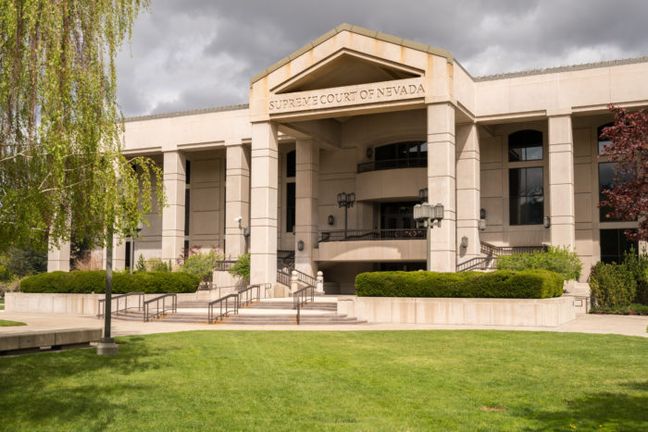On September 14, 2017, the Nevada Supreme Court issued an order amending Rule 36 of the Nevada Rules of Appellate Procedure (NRAP) so that unpublished opinions of the Nevada Court of Appeals can no longer be cited in court briefs. The order is known as ADKT 0504. The relevant portions of Rule 36(2) previously stated:
(2) An unpublished disposition, while publicly available, does not establish mandatory precedent except in a subsequent stage of a case in which the unpublished disposition was entered, in a related case, or in any case for purposes of issue or claim preclusion or to establish law of the case.
(3) A party may cite for its persuasive value, if any, an unpublished disposition issued by this court on or after January 1, 2016. When citing an unpublished disposition to this court, the party must cite an electronic database, if available, and the docket number and filing date in this court (with the notation “unpublished disposition”). A party citing an unpublished disposition must serve a copy of it on any party not represented by counsel.
See NRAP 36(2)-(3) (emphasis added).
The above form of Rule 36 went into effect relatively recently on January 1, 2016 (hereafter referred to as the “2016 Version”). What makes the Nevada Supreme Court’s decision more peculiar is that the 2016 Version came soon after the state finally established a court of appeals in 2015. Up until 2015, Nevada did not have a court of appeals between the Nevada Supreme Court and district courts. Before 2015, all appeals from district courts were heard directly by the Nevada Supreme Court, which greatly taxed its resources and created a large bottleneck of cases waiting to be heard.
Due to the backlog of appeals pending before the Nevada Supreme Court, it is no secret that case law or precedent in Nevada is sparse on most topics, which lawyers rely on to support their clients’ positions in arguments before the courts. In fact, prior to the 2016 Version, unpublished opinions of the Nevada Supreme Court itself could not be cited, with limited exceptions. Thus, the 2016 Version was in response to the newly-formed Nevada Court of Appeals and the decision to allow citation to unpublished opinions for their “persuasive value.”
As soon as the 2016 Version went into effect, lawyers in Nevada began citing unpublished opinions to support their positions. There was finally more precedent and persuasive authority to rely on to help their clients understand how the courts might rule in any given situation, and to help instruct the various courts on how the Nevada Supreme Court and Appellate Court has ruled under similar circumstances. Many believe unpublished opinions, although not binding precedent on lower courts, have value. As the dissenting Supreme Court justices to ADKT 0504 explained:
Like-situated parties deserve like legal treatment from an appellate court. If a party finds a case similar to his that the appellate court decided favorably to his cause, the party should be able to call the prior decision to the court’s attention and expect that the court will either decide his case the same way or explain the differences between the two cases that lead the court to decide them differently.
However, on September 14, 2017, in a 4 to 3 decision, the Nevada Supreme Court issued ADKT 0504, allowing only unpublished opinions of the Nevada Supreme Court to be cited. The decision came about due to the petition of Justice Michael A. Cherry, who wanted clarification that only Supreme Court decisions could be cited. A review of the language of the 2016 Version suggests the term “this court” is ambiguous as to whether it refers to the Nevada Supreme Court only or all appellate courts in Nevada, including the Court of Appeals.
In its decision to “clarify” the language of Rule 36, the majority of the Nevada Supreme Court explained its decision as follows:
WHEREAS, this court recognizes that although some cases on the Court of Appeals’ docket may raise discrete issues of interest to the legal community that are appropriately resolved by opinion, the majority of the caseload is comprised of error-correction cases that provide little persuasive value and are more efficiently resolved in non-citable unpublished orders.
In other words, the quality of the Court of Appeals’ unpublished opinions is not worthy of citation. In order for the Court of Appeals to get through its caseload quickly, it needs to be able to issue decisions without worrying about whether its reasoning in one case may be pointed out to it in a similar case at a future date, in which the Court of Appeals might decide to rule differently.
The majority’s view about Nevada Court of Appeals’ unpublished decisions is consistent with how most jurisdictions used to view all unpublished opinions. That is why unpublished opinions used to be banned in most jurisdictions. However, over time, the vast majority of jurisdictions have changed their stance and allow unpublished opinions to be cited for their persuasive value.
The dissenting justices in the ADKT 0504 order reject the majorities reasoning that the Court of Appeals’ caseload is “more efficiently resolved in non-citable unpublished orders.” The dissent argues the most important reason for allowing unpublished opinions of the Court of Appeals to be cited is “accountability.” “Appellate courts decide cases by written order; the order not only says who wins and who loses but explains, even if only briefly, why this is so. Like-situated parties deserve like legal treatment from an appellate court… While many [decisions] do not appear to make new law, if a party finds that the decision clarifies or advances the law in some helpful way, the disposition should be citable.”
The dissent also pointed out one of the reasons asserted by most for creating the Nevada Court of Appeals was to share the workload of the Nevada Supreme Court, which would then allow both courts to devote more time and attention to each case and, thereby, improve the quality of the courts’ opinions. In addition, the dissent argued the majority’s reasoning for disallowing citation to court of appeals’ unpublished opinions could apply equally to its own unpublished opinions.
Regardless of the dissent’s arguments, as of October 14, 2017, the amended version of Rule 36 will go into effect (hereafter referred to as the “2017 Version”). The 2017 Version will read as follows:
(3) A party may cite for its persuasive value, if any, an unpublished disposition issued by [this court] the Supreme Court on or after January 1, 2016. When citing such an unpublished [disposition to this court,] disposition, the party must cite an electronic database, if available, and the docket number and [filing date -in this court] date filed in the Supreme Court (with the notation “unpublished disposition”). A party citing such an unpublished disposition must serve a copy of it on any party not represented by counsel. Except to establish issue or claim preclusion or law of the case as permitted by subsection (2) unpublished dispositions issued by the Court of Appeals may not be cited in any Nevada court for any purpose.
Whether the 2017 Version will remain in force for long is unknown. Since it was a 4 to 3 decision, if the makeup of the Nevada Supreme Court shifts, it may issue a new amendment to Rule 36 and allow citation to Court of Appeals’ unpublished opinions. Yet, as a practical matter, the effect the 2017 Version will have on cases in Nevada is unknown. To legal professionals, it means there will be less Nevada case law to support one’s arguments and positions on issues.
For the litigation parties themselves, while some unpublished opinions of the Court of Appeals may be favorable to a party’s position, other unpublished opinions may be just as harmful. Therefore, the ban on citing unpublished opinions will be a mixed bag, depending on the issue.
Download or Print Article Here

 Author: Christopher Lund
Author: Christopher Lund
 Cannabis Workers Allege Quota to Trim 4 Pounds a Day Violates the California Labor Code
Cannabis Workers Allege Quota to Trim 4 Pounds a Day Violates the California Labor Code
 The Ninth Circuit Reminds Us: Every Word Matters
The Ninth Circuit Reminds Us: Every Word Matters
 NO WAY, PRO SE! The Consequences of Abusing the Judicial System as a Pro Se Litigant in Colorado
NO WAY, PRO SE! The Consequences of Abusing the Judicial System as a Pro Se Litigant in Colorado
 Victim of Financial Mismanagement or Unlawful Retaliation? New Jersey City University Program Founder Claims School Retaliated After Reporting Alleged Sexual Harassment
Victim of Financial Mismanagement or Unlawful Retaliation? New Jersey City University Program Founder Claims School Retaliated After Reporting Alleged Sexual Harassment
 “Real Housewives” Gets a Reality Check
“Real Housewives” Gets a Reality Check
 Missing a Chapter: Insufficiency of Expert Deposition Testimony in Medical Malpractice Litigation
Missing a Chapter: Insufficiency of Expert Deposition Testimony in Medical Malpractice Litigation
 Crash Course: Why Summary Judgment Misses the Mark in Illinois Multi-Cause Limousine Crash Collision
Crash Course: Why Summary Judgment Misses the Mark in Illinois Multi-Cause Limousine Crash Collision
 Bitter Truths: Lead, Cadmium, and Defective Pleadings in California Chocolate Class Action
Bitter Truths: Lead, Cadmium, and Defective Pleadings in California Chocolate Class Action
 The Law of Unintended Consequences: Including Insurance Brokers in Litigation Strategy Communication May Waive the Attorney-Client Privilege
The Law of Unintended Consequences: Including Insurance Brokers in Litigation Strategy Communication May Waive the Attorney-Client Privilege
 Federal Judge Throws Out Portion of Coverage Lawsuit in Nevada
Federal Judge Throws Out Portion of Coverage Lawsuit in Nevada
 Defenses Raised in an Answer Can Be Waived if Not Timely Reaffirmed in Discovery
Defenses Raised in an Answer Can Be Waived if Not Timely Reaffirmed in Discovery
 Nevada Court of Appeals Refuses to Define Breach of the Peace for Self-Help Repossession
Nevada Court of Appeals Refuses to Define Breach of the Peace for Self-Help Repossession
 Defendants Entitled to Attorney Fees as Prevailing Party in Voluntary Dismissal Cases Under Certain Circumstances
Defendants Entitled to Attorney Fees as Prevailing Party in Voluntary Dismissal Cases Under Certain Circumstances
 Nevada Limits Access to Police Body Camera Footage
Nevada Limits Access to Police Body Camera Footage
 Nevada Clarifies Exceptions to the American Rule of Attorney Fees
Nevada Clarifies Exceptions to the American Rule of Attorney Fees
 Actual Notice and Mailing Checks in Nevada
Actual Notice and Mailing Checks in Nevada
 Jury Demand within Complaint is Insufficient in Nevada
Jury Demand within Complaint is Insufficient in Nevada